Chelsea were out of the UEFA Champions League, but their season was far from ended because they had to secure a top-four position in the Premier League. Also, they were in the FA Cup final, and the players needed to be ready for it. However, on Saturday, the first day with the new owner, they suffered a 2-2 draw that felt like losing the game to Thomas Tuchel. At Stamford Bridge, Wolves were able to come back from two-goal behind to make it a draw.
The result was the result and it might not fully reflect the mixed performance of Chelsea. Of course, there were many departments they could improve, especially after the lead was established. But at the same time, the Blues also showed interesting positional structures which they executed in a very fine manner for most of the game.
This tactical analysis will have a deep study on Chelsea’s tactics with the ball, and explain why Tuchel made some changes during the game.
Lineups
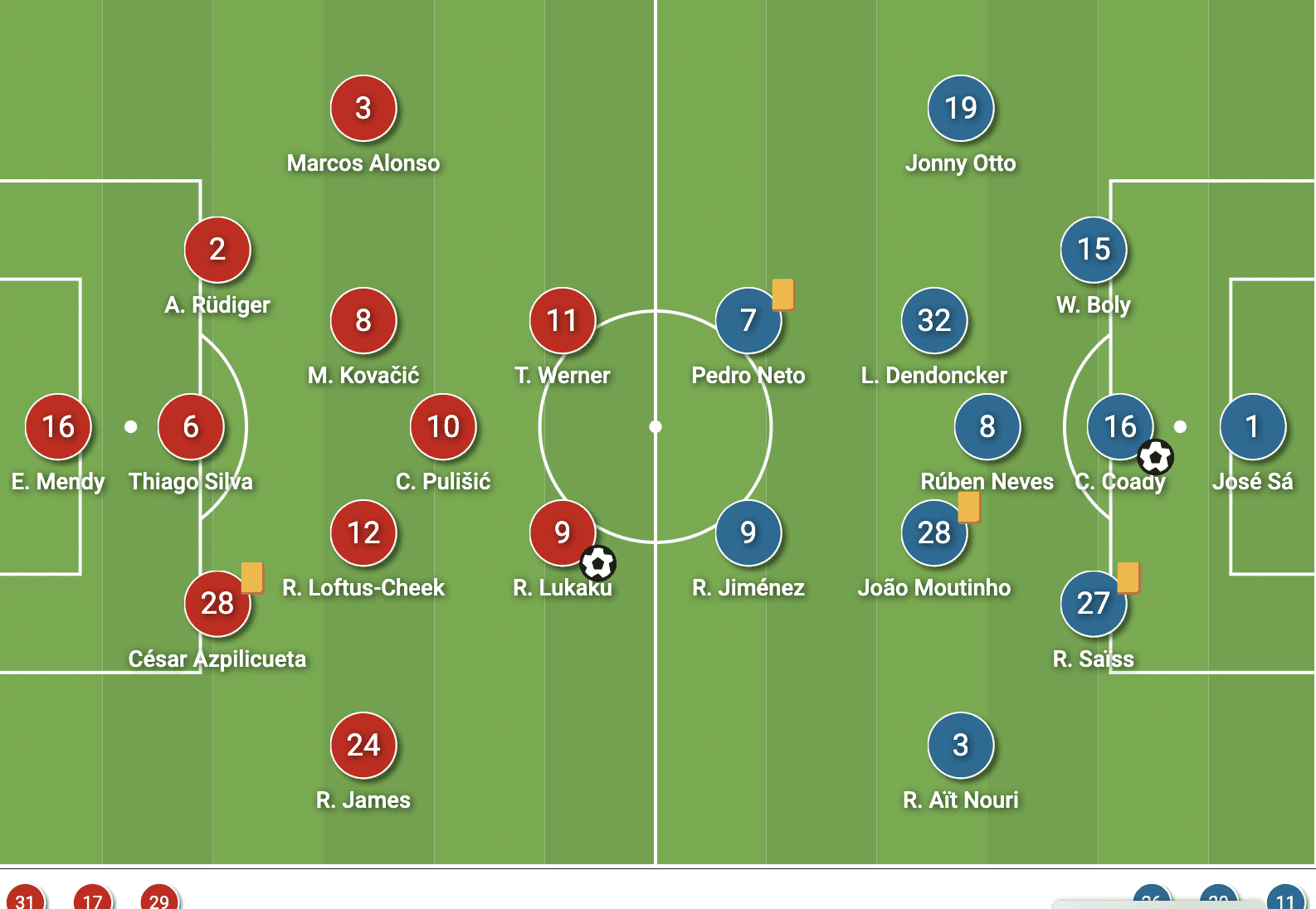
Chelsea were missing some key players due to injuries, such as Jorginho and N’Golo Kanté were unavailable. Hence, Mateo Kovačić and Ruben Loftus-Cheek paired up in the midfield, but the front three were not really wingers, as the shape was more like a 5-2-1-2 without the ball and 3-1-4-2 with the ball, as Christian Pulisic did not play high and wide.
Wolves suffered from a big loss at Brighton last week, and Bruno Lage made several changes and started a strong eleven in this game. Pedro Neto and Raúl Jiménez came back to play as the strikers in the 5-3-2, Hee-Chan Hwang and Fábio Silva started on the bench. Also, Jonny Otto replaced Nélson Semedo at the right wing-back position.
Play right to go left
As Tuchel himself described, the team is required to play with discipline in terms of keeping the structure to move the ball in this game. He felt that they controlled the game with a very offensive approach.
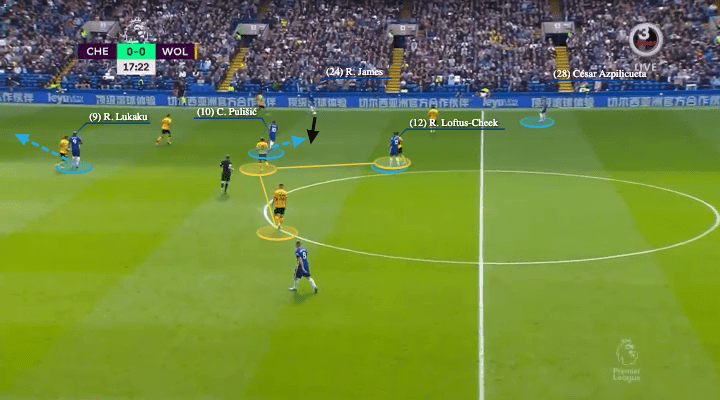
The approach, especially on the right side, relied on the close proximity of players to connect each other. They always had four to five players surrounding and supporting to give more passing options to the player on the ball. In this way, the right centre-back, César Azpilicueta pushed high and so he was closer to Reece James. Also, they wanted Romelu Lukaku and Timo Werner to fix the last line by some forward runs in behind, so there were two other options generated in spaces between the lines – Pulisic and Loftus cheek, in front and behind of the second line, as we have shown in the above image.
Here, James connected Pulisic between the lines, who dropped a bit to receive in spaces.
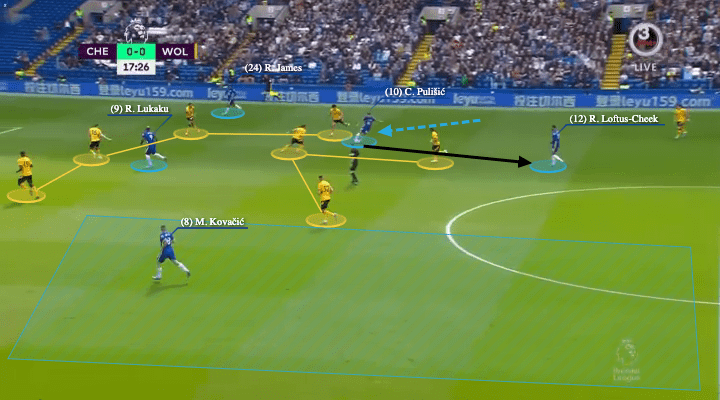
But the real secret of Chelsea’s offensive plan was not only bursting forward on the side with so many players, because the opponents could also see that and react by putting many players on that flank. Then, spaces were narrowed and it would be much more difficult to break.
Hence, Tuchel’s side was also dynamic as they were aware of the opposite flank. They knew that Wolves were going to play a 5-3-2 and that the three-man second line was unable to provide enough horizontal coverage. That means when the three Wolves midfielders were defending on one side, as shown with Kovačić’s positions above. The structure we explained in the above analysis, especially with the players between the lines, were the “windows” to help Chelsea get to the opposite space.
Here, Pulisic was given the license to carry the ball forward to see if Chelsea could break the last line, but if that condition was not presented, with the ball carrying that attracted the markers, the 6 in deeper space (Loftus-Cheek) was available. He could be the outlet to find the players on the other side.
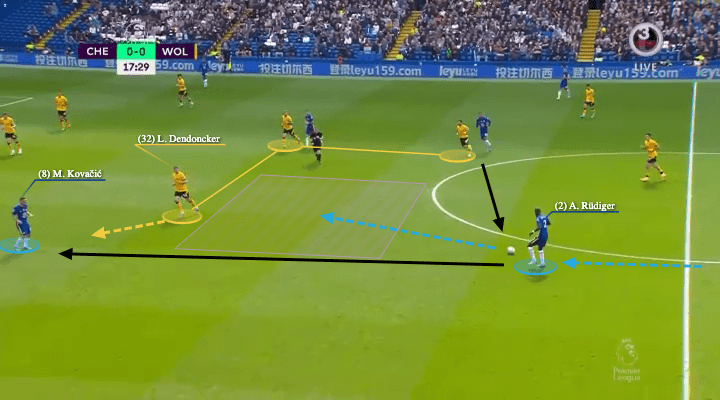
So you could see the passing sequence of Chelsea as shown in the above screenshot. When Loftus-Cheek received, he knew the other side was opened up and Antonio Rüdiger moved up to receive the short pass. Wolves were unable to catch the German international.
But then, the next question is about the timing to find Kovačić. Chelsea were still outside of the block and Leander Dendoncker, the Wolves far side 8 shifted with the clear intention to close the Croatian midfielder.
If the ball is passed forward in that instance, Dendoncker could reach Kovačić quickly, but Rüdiger did not let that happen as he chose to continue carrying the ball forward.
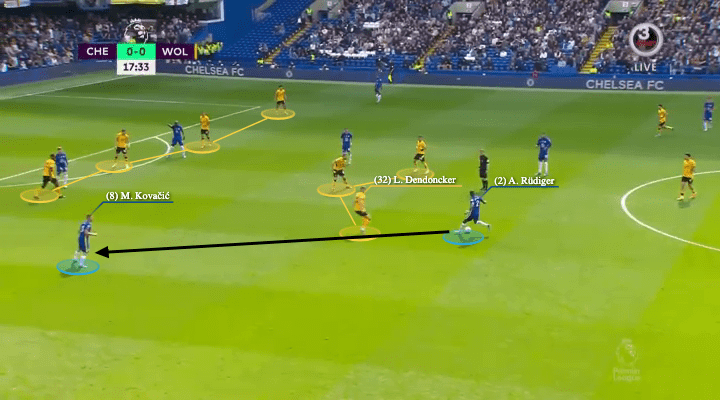
That “ball-carrying” decision from Rüdiger was very important, as the impact was shown in the next photo on the top. It invited Dendoncker to adjust his position and come out to engage the Chelsea defender. That also suggested the Wolves 8 gave up Kovačić, and so the Croatian was free in spaces to play the final pass or through pass to create the chances.
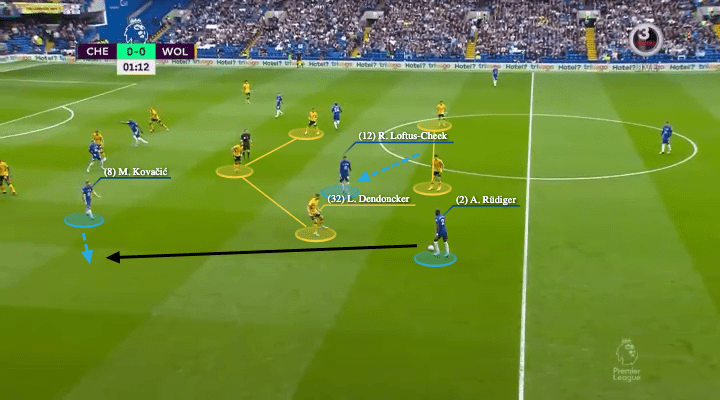
Specifically, you could see that Chelsea had a strong mindset to find Kovačić in spaces, the situation can be viewed from two perspectives. Firstly, Kovačić himself must be disciplined to receive in spaces, which means he should NOT pick up the ball by moving out, and staying behind the second line more often.
Meanwhile, Rüdiger, as the left side defender, he should always provoke a decisional dilemma on the Wolves 8 using that 3v2 (or 4v2) overload in the first line, carrying the ball forward to take Dendoncoker out of position, and having the courage to break lines to find Kovačić as shown above.
Also, there was another characteristic in Chelsea’s game as Marcos Alonso was given a high and wide role to attack in the final third, and not drop too deep to give Rüdiger a short option. We guess the reason for that arrangement was to avoid the ball going outside too early, and to prevent the Wolves defenders from jumping out to press out wide.
Good but imperfect structure
Although we explained so many positives and good things in Chelsea’s first-half structure, that was not a perfect system as the players did not adapt 100%. The situation is that the construction part in the first line was not secure enough against the two-man forward line, as Azpilicueta’s positional sense was not enough to integrate himself into the game in an effective manner.
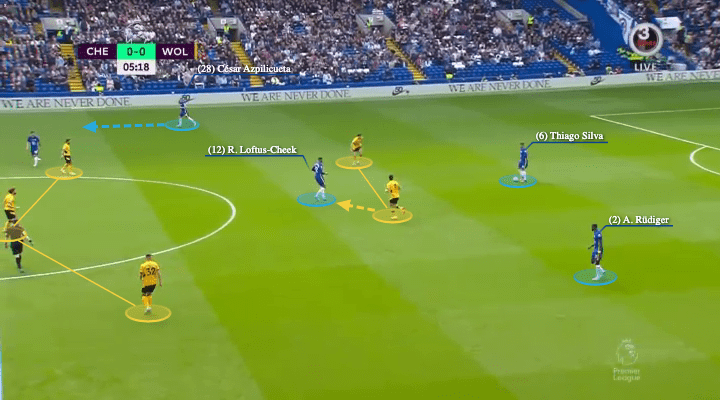
The problem of Chelsea was that when Azpilicueta was instructed to go higher to help James, he often did that too early. And when he moved high, he did not have the positional sense to drop back to give his centre-back partners more options. Hence, It often became a 3v2 in the build-up as shown above, with Loftus-Cheek as the 6, but that also made Wolves easier to press.
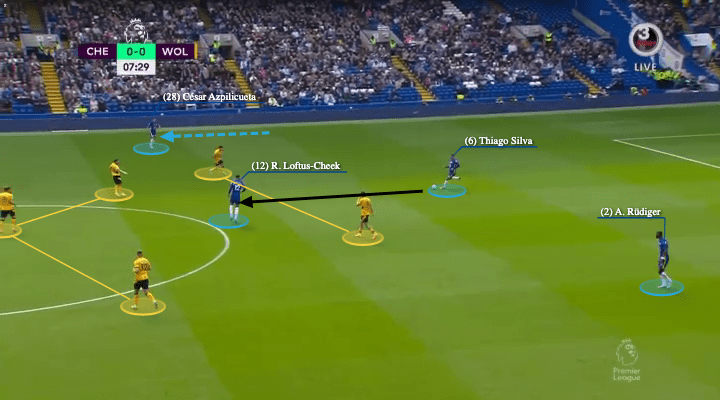
The situation and potential problems were included in this example, as Chelsea hold that 3-1 shape in the construction, and Azpilicueta once again moved so high and detach himself from Thiago Silva. That passing option was not on on the right side. Therefore, the former PSG defender could only go to Rüdiger or to the 6 in the centre, which he chose the latter option.
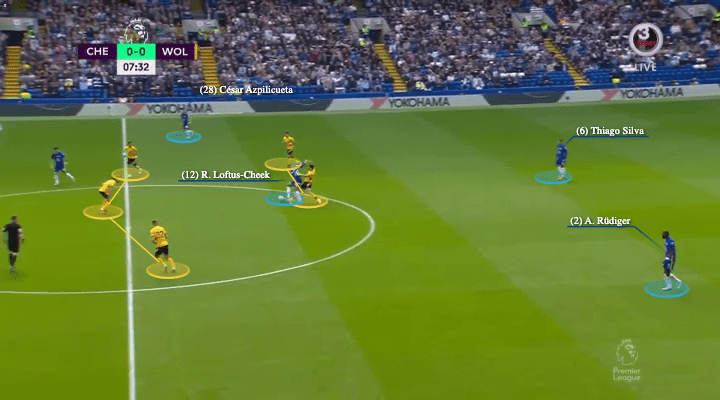
The consequence was that the Wolves strikers were able to see that very quickly and got back to the ground, or even challenged Loftus-Cheek to take the ball back as shown here. If possession turnover happened in this part of the pitch, Chelsea would suffer in the transitions as the opponent could run into them with many players.
And you can see, the position of Azpilicueta was not helpful enough as he was distancing himself from the others.
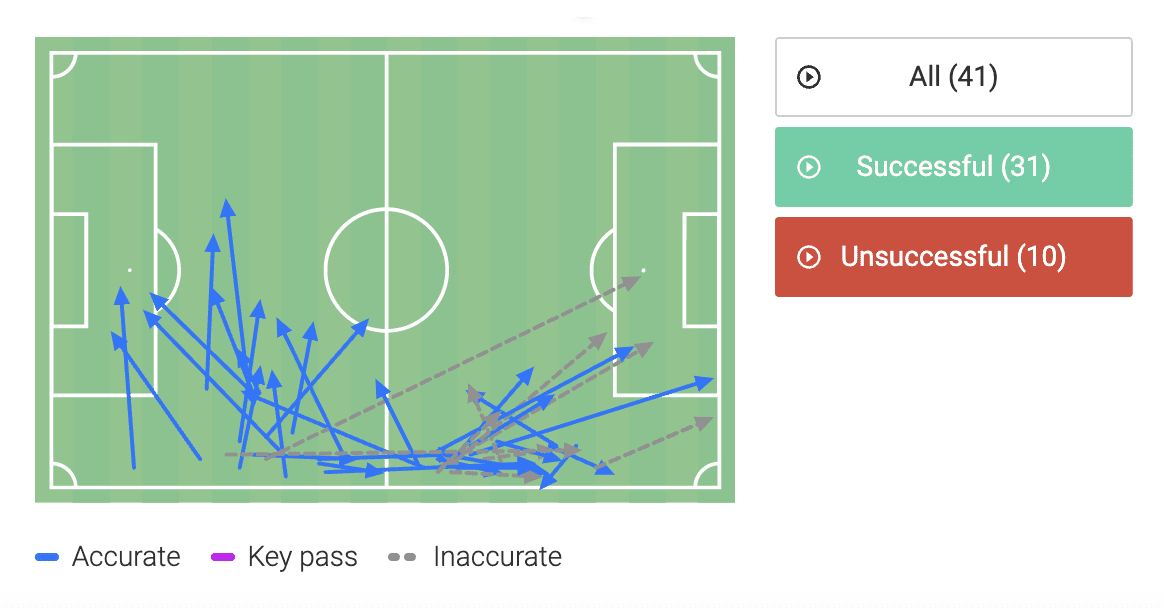
And in terms of control in the game, Chelsea were a bit rush in the first half as they sent some direct balls behind the lines. Some were okay but some long passes did not make sense.
From Azpilicueta’s first-half pass map above, a high tendency of unsuccessful long passes to spaces behind was shown, which gave the ball away back to Wolves and was not something Tuchel wanted.
Another perspective was that Azpilicueta was playing in a relatively wide position, you could see his passes were very close to the touchlines in the pass map as well.
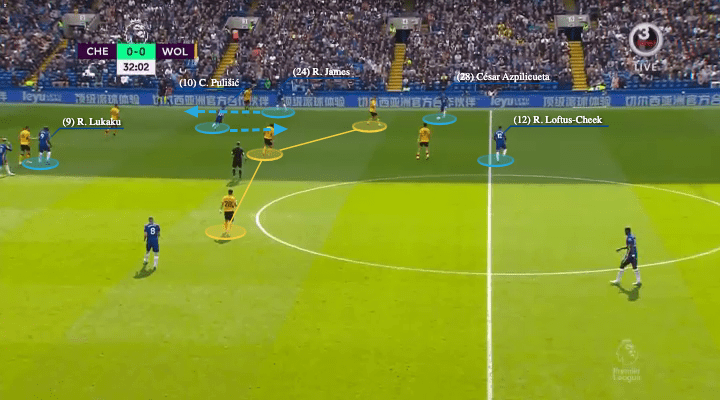
Translating the information above to the pitch, was that even though Chelsea had a good structure there, sometimes James and Azpilicueta killed each other’s space as they were stuck in the same vertical chain as shown above, that vertical pass would not happen as the defenders could easily close the wing-back on the back foot.
The changes
With the information and analysis of the game, Tuchel decided to replace Alonso with Saúl Ñiguez. Another change was swapping James and Azpilicueta’s positions, and they also reminded the team to stay with the structure with discipline.
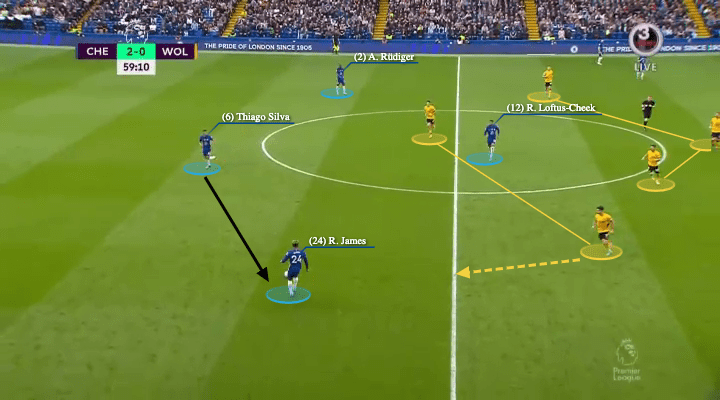
Since last season’s FA Cup final loss to Leicester City, some questioned whether James’ best position was right-back, right wing-back, but not many see his value as a right centre-back. In fact, he was one of the best candidates for Chelsea in that position if not the best, because he has good eyes to pass the ball forward, and good positional sense to help his team in the build-up.
With this example, we are going to show you how Chelsea improved the connectivity between players in the construction phases. Firstly, in the above image, the structure looked the same but James’ position was narrower than Azpilicueta’s, and that shortened distance gave Silva one more option so this pass from centre to right is on.
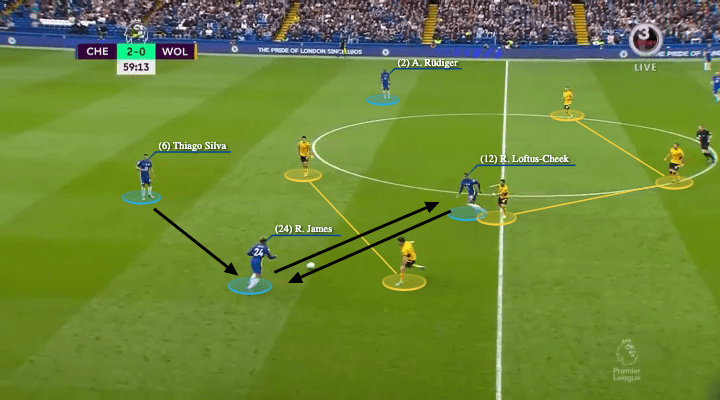
And James could attract the first line to open up spaces too! As Neto reacted and came out, he quickly exchanged a pass with Loftus-Cheek as the wall. Now, you could see the Wolves’ defensive shape was stretched and they no longer occupied the central spaces with the five players.
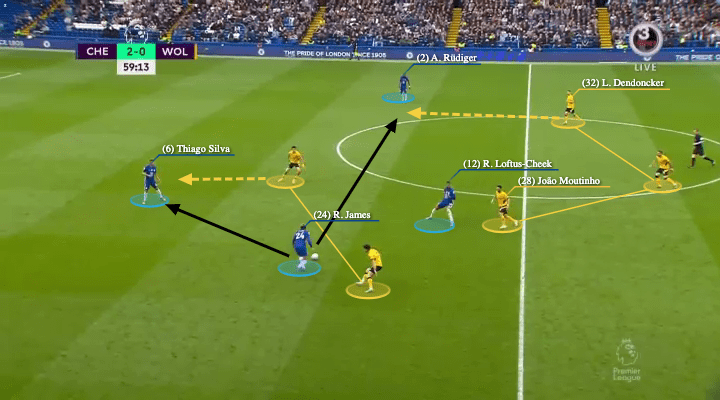
But when the ball came back to James, there was a situation which Chelsea could have fallen into a Wolves trap.
At the first glance, Silva and Rüdiger might be viable options but is this the right moment to pass? If you took a step back and think it again, it was not, because Dendoncker and Jiménez were lurking. To Rüdiger on the far side, the passing distance was too big and it was possible for Dendoncker to catch. And to Silva, Jiménez was very close and the Mexican forward was very capable of pressing in these situations.
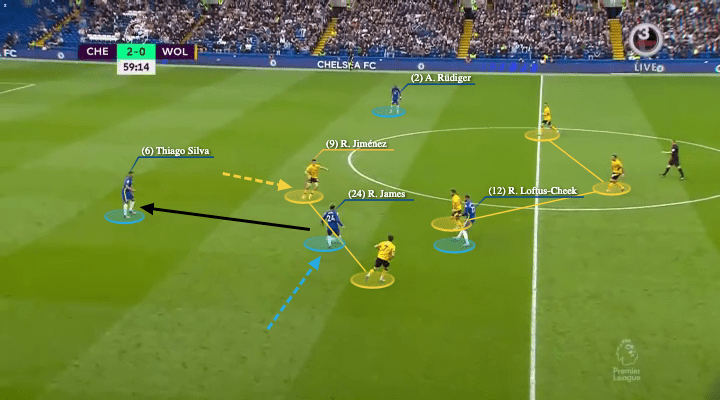
This was the good sense of James as a part of the construction, it was not only about the passes, but also related to how he perceived the situation and the decisions afterwards. James did not fall into the trap, and he was calm enough to take the ball inside, which invited Jiménez to press him – that means Jiménez was away from Silva and now the pass was much safer back to the centre.
And be aware of the action “taking the ball inside”, this was a very natural behaviour from James’ skillset but Azpilicueta in the same position might not be able to do the same as smooth as James.
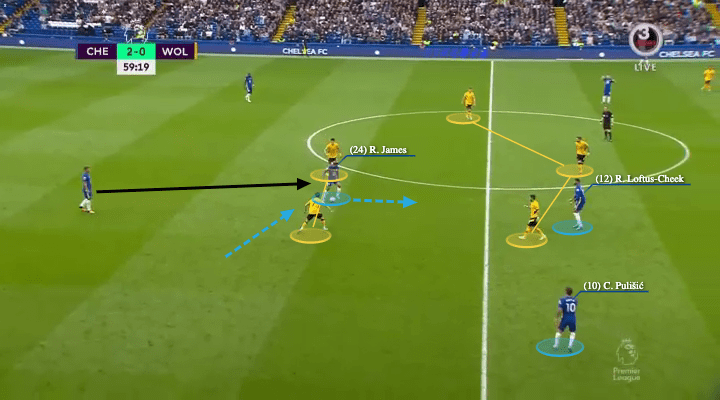
Furthermore, James’ presence was valuable as he was not only helping in the first moment, but also being able to provide himself as solutions in the follow-up actions to help his team to keep and move the ball in a longer sequence.
Although the pass was made, James did not stubbornly drop out to the same position again. Instead, he was clever to stay in spaces to receive another pass from Silva. And then this part was about how he used the far foot to take the ball to the right space correctly, beating the first line with such an action.
Then, Chelsea also had other two players to support as Loftus-Cheek moved higher, alongside Pulisic who came to the outside of the shape. Again, is this the moment to pass? Maybe it was, but James was able to give even more to the team.
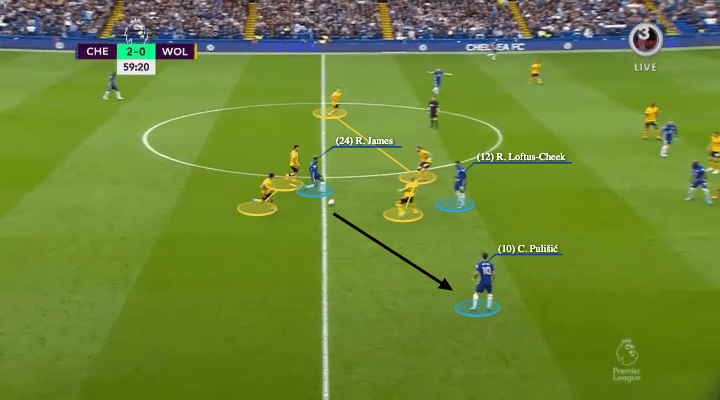
As we saw James, just one second later, with a few touches on the ball, he successfully attracted as many as FOUR Wolves players, and the block lost its shape and occupation of space, as a result of James’ action. Then, the Englishman defender was also calm enough to connect Pulisic, whose spaces was created by the actions of James and now Chelsea went all the way to face the last line.
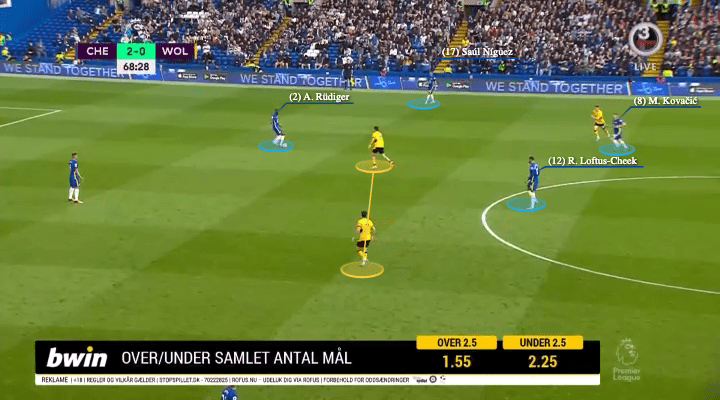
Alonso was a good player and a good presence in the penalty zone when given chances to attack, but his impact was also limited in the advanced areas. However, Tuchel realized that he needed better interconnectedness on the left side, and so he put Saúl there, who was better on the ball and also more comfortable in deeper spaces.
We also saw Kovačić moving deeper than the first half on occasions to create more options around the ball as shown above.
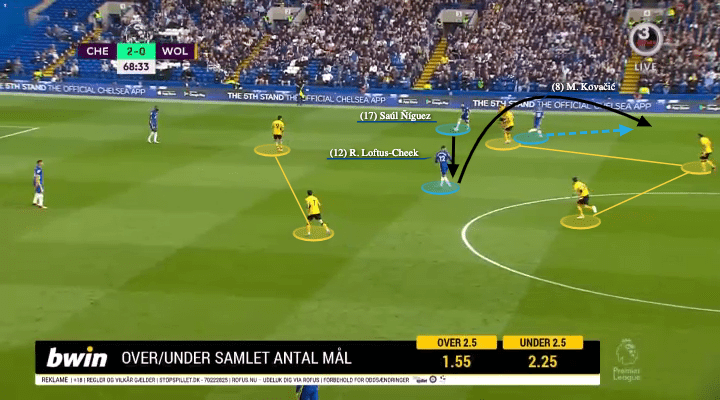
And so, there were some interesting passing sequences as the example above highlighted, with closer distances, Chelsea players did not have to carry the ball a lot, but they could use shorter passes to beat the press, or even do that line by line.
Conclusion
This was a very disappointing result for Chelsea, they were able to create threats in most parts of the game, but they could not find the third goal to kill the game. When that happened and they gave away the first goal cheaply, Wolves smelled something and they eventually get back into the game.
Despite the result was disappointing, through a few case studies, we were also able to see Tuchel’s flexible and dynamic tactics which fit in different players. They might not be at their best and lose points on occasions like this game in 2021/22, but if they continued on the work and have the beliefs in what they are doing, they could become one of the best teams in Europe with the ball in the future.





Comments